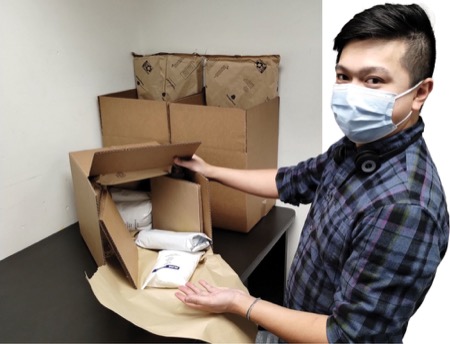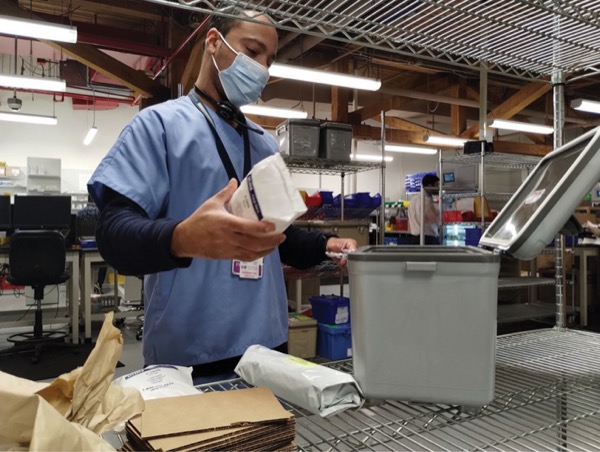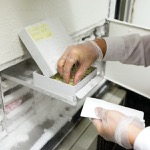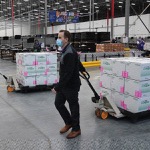Pharmacies and their suppliers are under increasing pressure to reduce the environmental impact of the temperature-controlled shipping process: the endless gel packs, EPS (expanded polystyrene, commonly known as Styrofoam [DuPont]) plastic foam, cardboard, phase-change materials (PCMs) and other products involved in maintaining medications at the precise temperature range needed for stability throughout the transport and storage process.
At the University of Connecticut, UConn Health’s Specialty Pharmacy had traditionally used cardboard shipping boxes with disposable ice packs to deliver specialty medications to its patients, who are primarily within range for local courier deliveries. They had moved to single-use recyclable boxes, but the burden fell on the patients to ensure that they actually got recycled (something that happened infrequently at best and led to patient complaints about the amount of waste left for them to manage).
In January 2022, UConn Health shifted to a fully circular system of reusable coolers, a step that has not only eliminated the need to recycle cardboard but has also cut its consumption of disposable ice packs by more than 90% while saving money and freeing up hundreds of square feet of pharmacy space. “We estimate that it would have taken 500 pallets of shipping supplies over the past year,” said Emmett Sullivan, BSPharm, the specialty pharmacy manager. “Instead, we ordered about 25 pallets of single-use supplies.”
The pharmacy tested several different models of coolers before they found one that met its standards. “Once we found one that could hold the temperature for at least 32 hours, and in most cases 36, we looked at how to do the packouts for warm day and cold day shipments,” Mr. Sullivan explained. “And we still do tests every quarter to confirm we are maintaining cold chain integrity throughout the seasons.”
The new containers—obtained on the open market, not from a specialized vendor—are durable enough for frequent reuse and high-enough quality to maintain cold chain transportation standards for several days. There was an initial acquisition cost of about $100 each, compared with about $12 in materials for a single-use package, but Mr. Sullivan said that paid for itself within the first month. “We also found ice packs that cost about 75% more than disposable packs, but are reusable,” he said.
Over the first two years of use, approximately 10% of the initial acquisition of 300 coolers have had to be replaced. Despite the initial increased investment in reusable materials, Mr. Sullivan estimates that the pharmacy saved about $112,000 in the first year after the switch. “We expect each cooler to last at least 25 months at this point,” he said.
Vendors in the cold chain space are making major investments in sustainability as well. “We have set a goal of 100 million pounds of landfill avoidance by 2025, and as of the end of June 2024, we had achieved greater than 80 million pounds toward that goal,” said Amardeep Chahal, the senior vice president for global marketing, strategy and corporate development with Cold Chain Technologies (CCT).
Beginning in 2019, CCT has introduced a growing portfolio of reusable shippers, including the EcoFlex, a parcel shipper, and the EndeavAir, a pallet shipper. “The EcoFlex is one of our lead offerings in the marketplace, and in a third-party verified ISO-compliant study, we found that it provided major environmental benefits compared to single-use EPS, including a 60% reduction in fossil fuel use and a 48% reduction in greenhouse gas emissions,” Mr. Chahal said. “We believe we currently have one of the largest reusable parcel fleets in the industry.”
Curbside recyclable solutions are also increasing in popularity, but they have limitations, Mr. Chahal said. “They are great for small-size parcel shippers, but some curbside recyclable materials like starch and cellulose lack some of the mechanical strength of EPS. They can be great for last-mile shipments, but for first-mile, large-size shipments, there is still work to be done.”
Toronto-based TempAid has focused its sustainability efforts on a combination of PCM mats and biodegradable EPS. “These PCM mats are non–water-based, and freeze and melt at or near the same temperatures as required of the products they protect,” explained Joe Futino Jr., the vice president of sales. “They’re made of a nontoxic, biodegradable material that saves weight, money and space, offering higher performance as well as reducing the environmental impact.”
TempAid’s Earthwise line of EPS coolers and shippers is based on a biodegradable bead that allows it to break down faster in landfills. “Every piece of EPS has these beads,” Mr. Futino said. “It’s not necessarily making great leaps and bounds in saving the environment, but it does break down more quickly than standard EPS. We also offer all of our standard cooler and shipper sizes in a curbside recyclable product, so that insulation is able to be dropped off in your blue bin.”
One of the company’s newest products, the SteadyPac Long Duration Cube, is a reusable high-performing shipper with a five-year lifespan. “It can consistently maintain stable temperatures for over 144 hours, depending on the specific solution,” Mr. Futino said.
Coldkeepers also offers a curbside recyclable paper one-piece thermal insulated box liner, made with postindustrial paper products and is both curbside recyclable and fully repulpable. “The liner is suitable for shipments of ambient, fresh, refrigerated and frozen products between 24 to 72 hours, which can be extended with gel packs or dry ice,” said Jeffrey Griffin, the director of business development and sales. “The paper liner simply inserts in the cardboard box and can be recycled just like that box by the end user. We continue to try to develop more paper-based solutions that are more easily recyclable.”
All of these environmentally sustainable cold chain solutions require an investment on the part of the end user, Mr. Chahal noted. “Within pharma, while there is growing recognition of the importance of driving a greener environment, these technologies remain in the relatively early stages of adoption,” he said. “Volumes are lower, which means that the costs of the materials are higher; they tend to be about a 20% premium overall compared with legacy solutions. That’s not bad, but it can be a barrier.”
The sources reported no relevant financial disclosures.
This article is from the November 2024 print issue.






